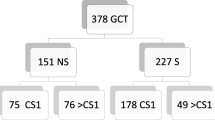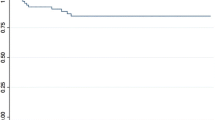Abstract
Purpose
Following radical orchiectomy, surveillance and primary retroperitoneal lymph node dissection (RPLND) are acceptable options for the management of early stage pure testicular teratoma in adult patients; however, there is no uniform consensus. The aim of this study was to investigate survival outcomes of adults with early stage pure testicular teratoma based on management strategy.
Methods
Data was extracted from the National Cancer Database (NCDB) from testicular cancer patients diagnosed with clinical stage (CS) I pure teratoma (pT1-4N0M0S0) between 2004 and 2014. Kaplan-Meier and Cox regression analyses were used to assess clinical outcomes based on management strategy.
Results
Of the 61,167 patients diagnosed with testicular cancer, 692 (1.1%) had pure teratoma. Only individuals with CS I disease were considered (n = 237). The median age was 28 (23–35) years. Overall, 43 (18%) patients underwent RPLND and 194 (82%) patients were managed with surveillance. There was an increase in surveillance for CS I teratoma during the study period. Increasing distance from residence to treatment facility was an unadjusted predictor for undergoing primary RPLND (p < 0.001). Median follow-up was 54 months and there was no significant difference in overall survival between CS I teratoma patients managed with RPLND and those managed with surveillance (p = 0.13).
Conclusions
There has been a trend toward increasing adoption of surveillance for the management of early stage pure testicular teratoma in adults. Our findings suggest that surveillance provides comparable survival outcomes to primary retroperitoneal lymph node dissection in this setting.



Similar content being viewed by others
References
Surveillance Epidemiology and End Results (SEER) Program. Cancer Stat Facts: Testicular Cancer 2019 https://seer.cancer.gov/statfacts/html/testis.html. Accessed August 5, 2019.
Pierorazio PM, Albers P, Black PC, et al. Non-risk-adapted surveillance for stage I testicular cancer: critical review and summary. Eur Urol. 2018;73(6):899–907.
Kollmannsberger C, Moore C, Chi KN, et al. Non-risk-adapted surveillance for patients with stage I nonseminomatous testicular germ-cell tumors: diminishing treatment-related morbidity while maintaining efficacy. Ann Oncol. 2010;21(6):1296–301.
Daugaard G, Gundgaard MG, Mortensen MS, et al. Surveillance for stage I nonseminoma testicular cancer: outcomes and long-term follow-up in a population-based cohort. J Clin Oncol. 2014;32(34):3817–23.
Wein AJ, Kavoussi LR, Campbell MF. Campbell–Walsh urology uro-oncology. 1st edn. Philadelphia, PA: Elsevier Saunders; 2015.
Simmonds PD, Lee AH, Theaker JM, Tung K, Smart CJ, Mead GM. Primary pure teratoma of the testis. J Urol. 1996;155(3):939–42.
David S, Andras F, Endre K, et al. More cases of benign testicular teratomas are detected in adults than in children. A clinicopathological study of 543 testicular germ cell tumor cases. Pathol Oncol Res. 2017;23(3):513–7.
Wetherell D, Weerakoon M, Williams D, et al. Mature and immature teratoma: a review of pathological characteristics and treatment options. Med Surg Urol. 2014;3(1):124.
Porcaro AB, Antoniolli SZ, Martignoni G, Brunelli M, Curti P. Adult primary teratoma of the testis—report on 5 cases in clinical stage I disease. Int Urol Nephrol. 2001;33(4):657–9.
Stephenson A, Eggener SE, Bass EB, et al. Diagnosis and treatment of early stage testicular cancer: AUA guideline. J Urol. 2019;202(2):272–81.
Kollmannsberger C, Tandstad T, Bedard PL, et al. Patterns of relapse in patients with clinical stage I testicular cancer managed with active surveillance. J Clin Oncol. 2015;33(1):51–7.
Hiester A, Nettersheim D, Nini A, Lusch A, Albers P. Management, treatment, and molecular background of the growing teratoma syndrome. Urol Clin North Am. 2019;46(3):419–27.
Scheckel CJ, Kosiorek HE, Butterfield R, Ho TH, Hilal T. Germ Cell tumors with malignant somatic transformation: a mayo clinic experience. Oncol Res Treat. 2019;42(3):95–100.
Karatzas A, Papadopoulos V, Katsiouli V, Pisters L, Papandreou C, Tzortzis V. Primitive neuroectodermal tumor transformation of testicular teratoma. Urol Ann. 2018;10(4):413–5.
Heidenreich A, Pfister D, Witthuhn R, Thuer D, Albers P. Postchemotherapy retroperitoneal lymph node dissection in advanced testicular cancer: radical or modified template resection. Eur Urol. 2009;55(1):217–24.
Leibovitch I, Foster RS, Ulbright TM, Donohue JP. Adult primary pure teratoma of the testis. The Indiana experience. Cancer. 1995;75(9):2244–50.
Peckham MJ, Barrett A, Horwich A, Hendry WF. Orchiectomy alone for stage I testicular non-seminoma. A progress report on the Royal Marsden Hospital study. Br J Urol. 1983;55(6):754–9.
Pizzocaro G, Zanoni F, Salvioni R, Milani A, Piva L. Surveillance or lymph node dissection in clinical stage I non-seminomatous germinal testis cancer? Br J Urol. 1985;57(6):759–62.
Freedman LS, Parkinson MC, Jones WG, et al. Histopathology in the prediction of relapse of patients with stage I testicular teratoma treated by orchidectomy alone. Lancet. 1987;2(8554):294–8.
National Comprehensive Cancer Network. Testicular cancer (Version 1.2019). 2019; https://www.nccn.org/professionals/physician_gls/pdf/testicular.pdf. Accessed August 15, 2019.
Vetterlein MW, Loppenberg B, Karabon P, et al. Impact of travel distance to the treatment facility on overall mortality in US patients with prostate cancer. Cancer. 2017;123(17):3241–52.
Onega T, Duell EJ, Shi X, Wang D, Demidenko E, Goodman D. Geographic access to cancer care in the U.S. Cancer. 2008;112(4):909–18.
Holmes JA, Carpenter WR, Wu Y, et al. Impact of distance to a urologist on early diagnosis of prostate cancer among black and white patients. J Urol. 2012;187(3):883–8.
Lin CC, Bruinooge SS, Kirkwood MK, et al. Association between geographic access to cancer care and receipt of radiation therapy for rectal cancer. Int J Radiat Oncol Biol Phys. 2016;94(4):719–28.
Lin CC, Bruinooge SS, Kirkwood MK, et al. Association between geographic access to cancer care, insurance, and receipt of chemotherapy: geographic distribution of oncologists and travel distance. J Clin Oncol. 2015;33(28):3177–85.
Ryan S, Serrell EC, Karabon P, et al. The association between mortality and distance to treatment facility in patients with muscle invasive bladder cancer. J Urol. 2018;199(2):424–9.
Woldu SL, Moore JA, Ci B, et al. Practice patterns and impact of postchemotherapy retroperitoneal lymph node dissection on testicular cancer outcomes. Eur Urol Oncol. 2018;1(3):242–51.
Chipollini J, Tang D, Zhou J, et al. Trends in insurance status during initial presentation of testicular carcinoma: examining health outcomes and implications of health reform for young adults in the United States. Urology Practice. 2019;6:1–6.
Dieckmann KP, Radtke A, Spiekermann M, et al. Serum levels of microRNA miR-371a-3p: a sensitive and specific new biomarker for germ cell tumours. Eur Urol. 2017;71(2):213–20.
Klaassen Z, Hamilton RJ. The role of robotic retroperitoneal lymph node dissection for testis cancer. Urol Clin North Am. 2019;46(3):409–17.
van Agthoven T, Eijkenboom WMH, Looijenga LHJ. microRNA-371a-3p as informative biomarker for the follow-up of testicular germ cell cancer patients. Cell Oncol (Dordr). 2017;40(4):379–88.
Acknowledgment
The data used in the study are derived from a de-identified NCDB file. The American College of Surgeons and the Commission on Cancer have not verified and are not responsible for the analytic or statistical methodology employed, or the conclusions drawn from these data by the investigators.
Author information
Authors and Affiliations
Corresponding author
Ethics declarations
Disclosure
All authors have no conflicts of interest to report regarding the data presented in this current study. All authors have read and approved this manuscript and it is not under consideration for publication elsewhere, nor has it previously been published. All authors have contributed to the information and material presented. No authors have direct or indirect commercial or financial incentives associated with the publication of this manuscript. No extra-institutional funding was required. The study was reviewed and approved by our institutional review board for ethics. We certify that the material in this assignment is our own work and not plagiarized.
Additional information
Publisher's Note
Springer Nature remains neutral with regard to jurisdictional claims in published maps and institutional affiliations.
Senior author: Wade J. Sexton.
Rights and permissions
About this article
Cite this article
Hajiran, A., Azizi, M., Aydin, A.M. et al. Retroperitoneal Lymph Node Dissection Versus Surveillance for Adult Early Stage Pure Testicular Teratoma: A Nationwide Analysis. Ann Surg Oncol 28, 3648–3655 (2021). https://doi.org/10.1245/s10434-021-09696-3
Received:
Accepted:
Published:
Issue Date:
DOI: https://doi.org/10.1245/s10434-021-09696-3




